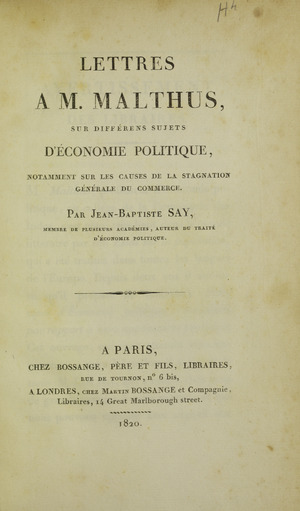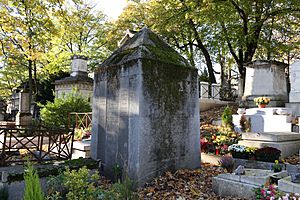Jean-Baptiste Say facts for kids
Quick facts for kids
Jean-Baptiste Say
|
|
|---|---|
 |
|
| Born | 5 January 1767 |
| Died | 15 November 1832 (aged 65) Paris, France
|
| Nationality | French |
| Field | Political economy |
| School or tradition |
French Liberal School |
| Influences | Richard Cantillon, Adam Smith, Pietro Verri |
| Contributions | Say's law, entrepreneurship |
Jean-Baptiste Say (born January 5, 1767 – died November 15, 1832) was a French economist and businessman. He believed in competition and free trade. He also thought that businesses should have fewer rules.
Say is famous for something called Say's law. It's also known as the "law of markets." He helped make this idea popular. Some experts aren't sure if he was the very first person to come up with it.
He was also one of the first economists to study entrepreneurship. He saw entrepreneurs as people who organize and lead the economy.
Contents
Early Life and Education

Jean-Baptiste Say was born in Lyon, France. His family was Protestant. They had moved to Geneva for a while because of a historical event called the Edict of Nantes.
Say was meant to work in business. In 1785, he went to England with his brother Horace to finish his schooling. He lived in Croydon and later in Fulham. In England, he worked for two sugar trading companies.
At the end of 1786, he traveled back to France with one of his bosses, Samuel Hibbert. Hibbert died in Nantes. Say then returned to Paris. There, he found a job at a life insurance company. His brother, Louis Auguste Say, also became an economist.
Writings and Teaching Career
Say's first writing was a short book about the freedom of the press in 1789. Later, he worked on a newspaper called Courrier de Provence. In 1792, he joined the army as a volunteer.
In 1793, during the French Revolution, he used the pen name Atticus. He became a secretary for the finance minister, Étienne Clavière.
From 1794 to 1800, Say edited a magazine called La Decade philosophique. In this magazine, he explained the ideas of Adam Smith, another famous economist. By this time, he was well-known for his writings.
When a new government was formed in 1799, he became one of the 100 members of the Tribunat. He stopped editing his magazine. In 1803, he published his most important book, Traité d'économie politique. This book explained how wealth is created and shared.
Say did not agree with Napoleon, so he was removed from his government job in 1804. He then started a business. He learned about making cotton and opened a spinning-mill in Auchy-lès-Hesdin. This factory employed about 400 to 500 people, mostly women and children.
He used his free time to update his economics book. However, the government had strict rules about what could be published, so he couldn't release the new version right away.
In 1814, after the allied powers entered France, Say was able to publish the second edition of his book. He dedicated it to Emperor Alexander I of Russia. That same year, the French government sent him to study the economy in the United Kingdom. He wrote about his findings in a book called De l'Angleterre et des Anglais. A third edition of his main book came out in 1817.
In 1819, he became a professor of industrial economy at the Conservatoire national des arts et métiers. In 1825, he joined the council of a business school, which is now considered the world's oldest business school. In 1831, he became a professor of political economy at the Collège de France. From 1828 to 1830, he published another big work, Cours complet d'économie politique pratique.
Understanding Say's Law
Say is most famous for "Say's law," or the "law of markets." This idea is often summed up in a few ways:
- "Supply creates its own demand."
- "Production makes its own market."
Some people, like John Maynard Keynes, criticized these ideas. But many economists believe Say's law means something simpler: "Production comes before consumption." Say believed that to buy things, you first have to produce something valuable. Then you can trade what you produced (either for money or other goods) to get what you want.
Other economists, like John Stuart Mill and James Mill, had similar ideas. James Mill wrote in 1808 that "producing goods creates a market for those goods."
Say himself explained it this way: "Products are paid for with products." He also said that if you make something, it immediately creates a way for other products to be sold. When a producer finishes a product, they want to sell it quickly. They also want to spend the money they get from it, because money can lose its value. The only way to spend money is to buy other products. So, making one product helps other products get sold.
Say also pointed out that having lots of money isn't what helps sales. Instead, having lots of other products available makes it easier to sell things. He said that money is just a temporary tool in trade. In the end, one type of good is always exchanged for another.
Say's law became important during the early Industrial Revolution. At that time, factories were making more goods, but sometimes sales would drop, and people would lose jobs. This made some people think there was a limit to how much could be produced. Say's law explains that when goods are produced, income is paid to the workers, landowners, and capital owners. The price of the goods covers these payments. So, if more goods are produced, more income is created, which then helps people buy those goods. As Say said, "unless we produce, we cannot consume."
The Role of Entrepreneurs
In his main book, Say explained that any production needs effort, knowledge, and the work of an entrepreneur. He saw entrepreneurs as people who connect different parts of production, like land, money, and workers. They do this to meet what customers want. Because of this, entrepreneurs are very important in the economy. They help organize everything.
Say didn't just study big business owners. He also looked at people who work for themselves. He said that a street vendor, like a knife sharpener, is both a worker and an entrepreneur.
Say also thought about what makes a good entrepreneur. He said that good judgment is key. Entrepreneurs need to constantly figure out what the market needs and how to provide it. This requires a strong "market sense."
Say believed that entrepreneurs earn high wages because of their skills and knowledge. He separated the role of the entrepreneur from the role of someone who just provides money. This allowed him to look at the entrepreneur's earnings separately from the money earned from capital.
He also talked about risk and uncertainty in business, and how new ideas (innovation) play a part. He noted that in any business, there are "obstacles to overcome, worries to manage, problems to fix, and solutions to invent." He added that there is always some risk involved. Sometimes, a manufacturer finds a new way to make a product, make an old product better, or produce things more cheaply.
Personal Life and Later Years
In 1793, Say married Mlle Deloche. Her father was a lawyer.
In 1826, Say was chosen as a foreign member of the Royal Swedish Academy of Sciences.
In his later years, Say had health problems. His wife passed away in January 1830, and his health got worse after that. When the revolution happened that year, Say was asked to join a local council, but he had to resign due to his health.
Jean-Baptiste Say died in Paris on November 15, 1832. He was buried in the Père Lachaise Cemetery.
Images for kids
See also
 In Spanish: Jean-Baptiste Say para niños
In Spanish: Jean-Baptiste Say para niños




